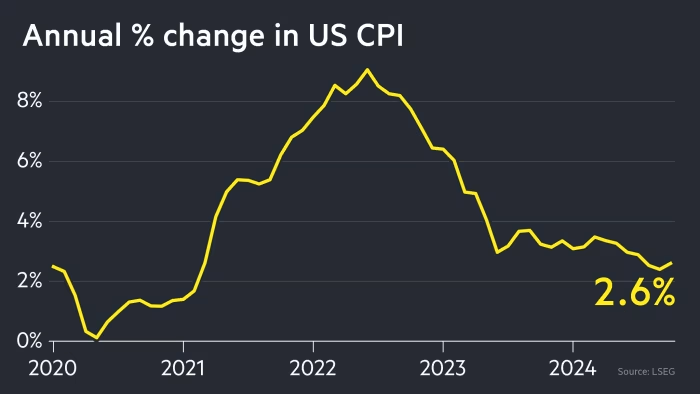Inflation in the United States continued its upward trend for the second consecutive month in November, according to the latest government data. The consumer price index (CPI), which measures the average change in prices paid by consumers for goods and services, rose by 2.7% compared to the same period last year, slightly above October’s 2.6%.
This development adds complexity to the Federal Reserve’s ongoing efforts to manage inflation and guide the economy toward stability.
The November CPI figures, published by the U.S. Labor Department, matched the expectations of economists surveyed by Dow Jones Newswires and The Wall Street Journal. While the slight uptick aligns with forecasts, it underscores the challenges the Federal Reserve faces in bringing inflation back to its long-term target of 2%.

Core inflation, a key measure that excludes the often-volatile categories of food and energy, rose by 3.3% year-on-year in November.
This metric provides a clearer view of underlying inflation trends and also came in as anticipated. Both the headline and core inflation rates increased by 0.3% from the previous month, suggesting persistent price pressures across various sectors of the economy.
READ ALSO: Kimberly Guilfoyle Named U.S. Ambassador to Greece
The Federal Reserve has been actively adjusting its monetary policy to combat inflation, which surged to multi-decade highs in recent years. After raising interest rates aggressively to curb demand and cool price growth, the central bank has begun gradually lowering rates.
Currently, the Fed’s benchmark interest rate sits in the range of 4.50% to 4.75%, down 0.75% from its peak in September.

Despite this progress, the recent rise in inflation complicates the Fed’s next steps. Financial markets widely expect a further quarter-point rate cut during the Fed’s upcoming policy meeting, according to data from CME Group.
For consumers, inflation directly affects purchasing power, as higher prices make goods and services more expensive. While inflation slowed significantly earlier this year—dropping to a low of 2.4% in September—it has since begun to rise again, albeit gradually.
READ ALSO: SEC Commissioner Calls for Reform of Crypto Regulations
This recent uptick is driven by a combination of factors, including resilient consumer demand, lingering supply chain issues, and broader global economic dynamics.
The cost of essential items such as housing, healthcare, and transportation continues to exert pressure on household budgets, even as the economy shows signs of stabilization.

Despite the recent increases, many analysts and Federal Reserve officials remain optimistic about the broader trajectory of inflation. Most believe that the pressures driving inflation higher will eventually ease, allowing the Fed to achieve its long-term target.
The Fed’s monetary policy decisions will play a critical role in shaping this outcome. Lowering interest rates too quickly could risk reigniting inflation, while maintaining higher rates for too long might stifle economic growth and consumer spending. This delicate balancing act highlights the complexity of navigating the post-pandemic economic landscape.
The Federal Reserve’s next steps will depend heavily on incoming economic data. If inflation continues to rise, the central bank may need to pause or slow its rate-cutting cycle to avoid overheating the economy. Conversely, if inflation resumes its downward trend, the Fed may feel more confident in easing monetary policy further.
AFP
Discover more from Cine critique
Subscribe to get the latest posts sent to your email.

